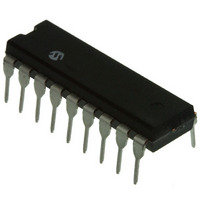PIC16F88-I/P Microchip Technology, PIC16F88-I/P Datasheet - Page 39

PIC16F88-I/P
Manufacturer Part Number
PIC16F88-I/P
Description
IC MCU FLASH 4KX14 EEPROM 18DIP
Manufacturer
Microchip Technology
Series
PIC® 16Fr
Datasheets
1.PIC16F616T-ISL.pdf
(8 pages)
2.PIC16F688T-ISL.pdf
(688 pages)
3.PIC16F818-ISO.pdf
(6 pages)
4.PIC16F87-IP.pdf
(228 pages)
5.PIC16F87-IP.pdf
(8 pages)
6.PIC16F87-IP.pdf
(4 pages)
7.PIC16F87-IP.pdf
(8 pages)
8.PIC16F88-ISO.pdf
(214 pages)
Specifications of PIC16F88-I/P
Program Memory Type
FLASH
Program Memory Size
7KB (4K x 14)
Package / Case
18-DIP (0.300", 7.62mm)
Core Processor
PIC
Core Size
8-Bit
Speed
20MHz
Connectivity
I²C, SPI, UART/USART
Peripherals
Brown-out Detect/Reset, POR, PWM, WDT
Number Of I /o
16
Eeprom Size
256 x 8
Ram Size
368 x 8
Voltage - Supply (vcc/vdd)
4 V ~ 5.5 V
Data Converters
A/D 7x10b
Oscillator Type
Internal
Operating Temperature
-40°C ~ 85°C
Processor Series
PIC16F
Core
PIC
Data Bus Width
8 bit
Data Ram Size
368 B
Interface Type
SSP/USART
Maximum Clock Frequency
20 MHz
Number Of Programmable I/os
16
Number Of Timers
3
Operating Supply Voltage
2 V to 5.5 V
Maximum Operating Temperature
+ 85 C
Mounting Style
Through Hole
3rd Party Development Tools
52715-96, 52716-328, 52717-734
Development Tools By Supplier
PG164130, DV164035, DV244005, DV164005, PG164120, ICE2000, DM163014
Minimum Operating Temperature
- 40 C
On-chip Adc
7-ch x 10-bit
Lead Free Status / RoHS Status
Lead free / RoHS Compliant
For Use With
ACICE0202 - ADAPTER MPLABICE 18P 300 MILAC164010 - MODULE SKT PROMATEII DIP/SOIC
Lead Free Status / Rohs Status
Lead free / RoHS Compliant
Available stocks
Company
Part Number
Manufacturer
Quantity
Price
Company:
Part Number:
PIC16F88-I/P
Manufacturer:
Microchi
Quantity:
6 825
Part Number:
PIC16F88-I/P
Manufacturer:
MICROCH
Quantity:
20 000
4.4
For timing insensitive applications, the “RC” and
“RCIO” device options offer additional cost savings.
The RC oscillator frequency is a function of the supply
voltage, the resistor (R
ues, and the operating temperature. In addition to this,
the oscillator frequency will vary from unit to unit due to
normal manufacturing variation. Furthermore, the dif-
ference in lead frame capacitance between package
types will also affect the oscillation frequency,
especially for low C
take into account variation due to tolerance of external
R and C components used. Figure 4-4 shows how the
R/C combination is connected.
In the RC Oscillator mode, the oscillator frequency
divided by 4 is available on the OSC2 pin. This signal may
be used for test purposes or to synchronize other logic.
FIGURE 4-4:
The RCIO Oscillator mode (Figure 4-5) functions like
the RC mode, except that the OSC2 pin becomes an
additional general purpose I/O pin. The I/O pin
becomes bit 6 of PORTA (RA6).
FIGURE 4-5:
2003 Microchip Technology Inc.
Recommended values: 3 k
R
C
V
R
C
V
Recommended values: 3 k
EXT
EXT
SS
SS
EXT
EXT
V
V
RC Oscillator
DD
DD
RA6
F
OSC
EXT
/4
RC OSCILLATOR MODE
OSC1
RCIO OSCILLATOR MODE
OSC1
OSC2/CLKO
EXT
I/O (OSC2)
values. The user also needs to
C
C
EXT
EXT
) and capacitor (C
> 20 pF
> 20 pF
R
R
EXT
EXT
PIC16F87/88
PIC16F87/88
100 k
100 k
Internal
Internal
Clock
Clock
EXT
) val-
Preliminary
4.5
The PIC16F87/88 devices include an internal oscillator
block, which generates two different clock signals;
either can be used as the system’s clock source. This
can eliminate the need for external oscillator circuits on
the OSC1 and/or OSC2 pins.
The main output (INTOSC) is an 8 MHz clock source,
which can be used to directly drive the system clock. It
also drives the INTOSC postscaler which can provide a
range of six clock frequencies from 125 kHz to 4 MHz.
The other clock source is the internal RC oscillator
(INTRC) which provides a 31.25 kHz (32 s nominal
period) output. The INTRC oscillator is enabled by
selecting the INTRC as the system clock source, or
when any of the following are enabled:
• Power-up Timer
• Watchdog Timer
• Two-Speed Start-up
• Fail-Safe Clock Monitor
These features are discussed in greater detail in
Section 15.0 “Special Features of the CPU”.
The clock source frequency (INTOSC direct, INTRC
direct, or INTOSC postscaler) is selected by configuring
the IRCF bits of the OSCCON register (page 40).
Note:
Internal Oscillator Block
Throughout this data sheet, when referring
specifically to a generic clock source, the
term “INTRC” may also be used to refer to
the clock modes using the internal oscilla-
tor block. This is regardless of whether the
actual
(8 MHz), the INTOSC postscaler, or
INTRC (31.25 kHz).
frequency
PIC16F87/88
used
DS30487B-page 37
is
INTOSC




















